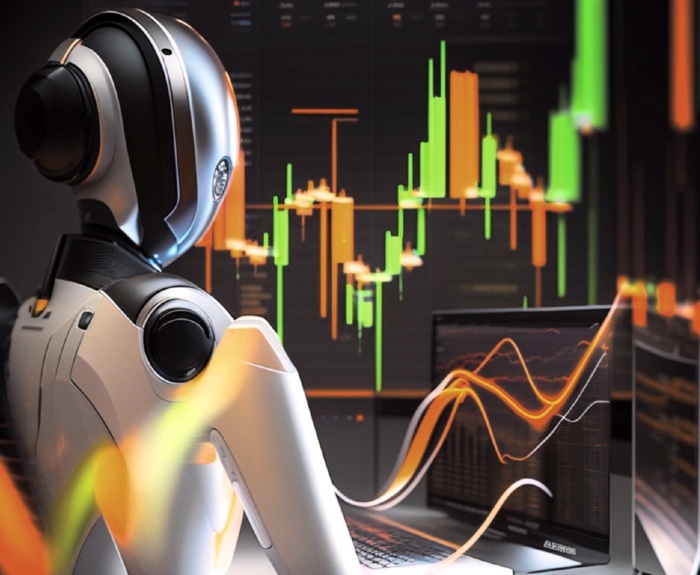Why AI is Transforming Trading & Market Predictions
Financial markets are faster, more complex, and more data-driven than ever. Investors, hedge funds, and financial institutions are turning to AI-powered algorithmic trading to analyze millions of data points in real time, optimize trade execution, and maximize returns.
For traders, investors, and financial analysts, AI-driven trading offers:
✔ High-speed, automated trade execution
✔ Smarter market predictions using machine learning
✔ Data-driven portfolio management
✔ Lower trading risks through AI-driven insights
In this article, we’ll explore:
- What AI in algorithmic trading means
- How AI models predict market movements
- The benefits and risks of AI-powered trading
- How traders and investors can leverage AI for better financial decisions
Let’s dive in!
What is AI in Algorithmic Trading?
Definition
AI in algorithmic trading refers to using artificial intelligence, machine learning, and data science to execute trades automatically based on real-time market data, trends, and predictions.
Unlike traditional trading, which relies on human decision-making, AI trading uses:
✔ Deep learning models to identify market patterns
✔Predictive analytics for price movement forecasting
✔AI-powered bots for high-frequency trading
✔ Risk assessment models to minimize losses
AI-driven trading is faster, more efficient, and more accurate than human traders.
How AI is Powering Algorithmic Trading
1. High-Frequency Trading (HFT) with AI
✔ AI-powered high-frequency trading (HFT) systems execute thousands of trades per second.
✔ AI detects micro price changes and arbitrage opportunities before human traders can react.
Example:
- Citadel Securities uses AI-driven HFT algorithms to optimize execution speed and liquidity.
2. AI-Driven Market Sentiment Analysis
✔ AI analyzes news articles, social media, and earnings reports to gauge market sentiment.
✔ AI models predict how investor emotions impact stock prices.
Example:
- Bloomberg Terminal’s AI sentiment tool predicts stock movements based on news sentiment analysis.
3. Predictive Analytics for Stock Market Forecasting
✔ AI models use historical data and real-time market trends to forecast price movements.
✔ Machine learning algorithms adjust predictions as new data becomes available.
Example:
- Renaissance Technologies uses AI to analyze market signals and optimize hedge fund strategies.
4. AI-Powered Trading Bots for Automated Investing
✔ AI trading bots execute trades 24/7 with precision.
✔ AI adjusts trading strategies based on real-time market changes.
Example:
- Alpaca’s AI-powered trading bots allow automated stock trading for retail investors.
5. AI Risk Management & Fraud Detection
✔ AI detects market anomalies and fraudulent trading behavior.
✔ AI prevents trading manipulation and insider trading risks.
Example:
- JPMorgan Chase’s AI fraud detection system protects traders from market fraud.
Challenges & Risks in AI-Driven Trading
While AI trading has major advantages, it also comes with risks:
1. Market Volatility & Flash Crashes
- AI-driven HFT can trigger extreme market fluctuations.
- Sudden AI trading decisions may lead to rapid sell-offs or flash crashes.
2. AI Bias & Algorithm Errors
- AI models can inherit biases from historical market data.
- Incorrect AI predictions can lead to significant financial losses.
3. Regulatory & Compliance Issues
- AI trading must follow SEC, FCA, and global financial regulations.
- Governments are still defining AI trading laws and oversight policies.
4. AI Transparency & Black-Box Decision Making
- Many AI trading models lack explainability, making it hard to understand why a trade was made.
- Investors need AI tools with clear decision-making logic.
Case Studies: AI Trading in Action
🔹 Case Study: AI Trading at Bridgewater Associates
- Challenge: Needed a data-driven trading strategy for hedge fund growth.
- Solution: Developed AI-powered market prediction models.
- Result: Higher portfolio returns and reduced risk exposure.
🔹 Case Study: AI Sentiment Trading at Goldman Sachs
- Challenge: Traditional market analysis missed real-time sentiment shifts.
- Solution: AI-based news sentiment tracking for stock price prediction.
- Result: More accurate market timing and investment decisions.
Step-by-Step Guide: How to Use AI for Trading
Step 1: Choose an AI-Powered Trading Platform
✔ Research AI-driven trading platforms like QuantConnect, Alpaca, and TradeStation.
Step 2: Use AI for Market Research & Trend Analysis
✔ Leverage AI tools like Bloomberg Terminal’s AI sentiment analysis.
✔ Monitor AI-generated technical indicators and pattern recognition tools.
Step 3: Automate Trading Strategies with AI Bots
✔ Set up AI trading bots to execute trades based on preset market conditions.
✔ Backtest AI models using historical financial data.
Step 4: Monitor AI Trading Performance & Adjust Strategies
✔ Regularly analyze AI trading performance metrics.
✔ Combine AI automation with human oversight for risk management.
Conclusion & Call to Action
AI is revolutionizing trading and financial market predictions, offering high-speed execution, smarter market forecasting, and automated investing.
Want expert guidance on AI-powered trading or FinTech investment strategies? Our bilingual agency specializes in AI investment consulting, algorithmic trading strategies, and financial market insights. Contact us today to explore AI-driven trading opportunities!
Disclaimer: This article is for informational purposes only. Consult a financial expert before using AI for trading or investing.

